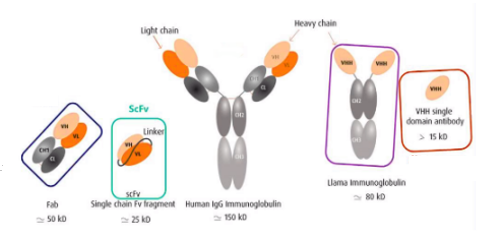2024-05-20 Hits(364)
Antibody Discovery
Production Method of Nanobody
A nanobody (Nb) is also known as a single-domain antibody. Its development is different from that of traditional monoclonal antibodies prepared by hybridoma. Nanobody is generally screened by immunizing alpaca, constructing a phage library, and displaying phage, and then is expressed and purified by nanobody to verify whether it binds to the antigen.
Immunizing alpaca generally obtains single-domain antibodies. After the antibody of the immune system itself in alpaca matures, B lymphocytes are isolated, RNA is extracted, cDNA is obtained by reverse transcription, cDNA is used as a substrate for PCR amplification to obtain diversified nanoparticle antibody gene fragments, and then the diversified nanoparticle antibody gene fragments are connected to phage granules to construct phage library. The suitable antibody was obtained by phage display screening technology, and the nanobody was verified. The process mainly includes alpaca immunization, phage library construction, antibody screening, expression purification, and validation.

Figure 1: Structure diagram of the nanobody(KMD Bioscience)
Production Process of Nanobody
Different from the classical hybridoma technique for monoclonal antibody preparation, the whole process of nanobody development mainly includes alpaca immunization, phage library construction, antibody screening, expression purification, and verification. After immunizing the alpaca, B lymphocytes were isolated from the peripheral blood of the alpaca, total RNA was extracted and reverse-transcribed into cDNA, which was used as a template for PCR amplification to obtain a variety of nanobody gene fragments, and then connected to the vector to construct phage library. Then, the antigen-specific nanobodies were obtained by multiple rounds of panning, and sequenced, expressed, and verified.

Figure 2: Production process of nanobody(KMD Bioscience)
KMD Bioscience has established a complete mammalian expression system for antibody expression, including but not limited to cell lines such as FreeStyle 293-F cell line and Expi CHO-S. Recombinant antibodies were expressed and prepared in conjunction with a high-expression vector designed by KMD Bioscience (containing a full-length CMV promoter and an optimized secreted signaling peptide sequence). After the expression was completed, the nanobody was purified by a nickel column. Then the purified nanobody was tested by Biacore affinity.

Figure 3: Picture of expression result of Fc-VHH nanobody(KMD Bioscience)
Advantages of Nanobody
① The biophysical and biochemical properties of nanobodies are particularly stable, including solubility, heat resistance, and proteolytic resistance.
②Large-scale production of nanobody is easier to achieve. Because of the long amino acid sequence and complex protein structure, the production of traditional antibodies requires complex instruments and can only be realized in eukaryotic systems. In addition, in the use of clinical antibody drugs, to achieve therapeutic effects, usually give large doses of drugs. These two aspects lead to the production of traditional antibodies requiring the use of a large number of mammalian cells and lengthy screening and purification steps, and the production cost is very expensive[3]. Nanobodies can be expressed in a large number of microbial systems (such as bacteria, yeast, and fungi), and can be quickly screened in display libraries, making nanobodies have lower production costs.
③ The immunogenicity of nanobodies is low. The structure of the nanobody is very similar to that of the heavy chain variable region VH of a human antibody, including three hypervariable regions (hypervariable region (HVR) and four framework regions (FR) on both sides and its gene homology is 90%. This means that the immunogenicity of nanobodies is relatively low, and so far, there have been no reports of adverse reactions caused by the immunogenicity of nanobodies.
④ Nanobody molecular weight is small, tissue penetration ability is strong, and blood clearance is faster. The passive diffusion rate of drugs between cells in tissues is inversely proportional to the size of drug molecules. Therefore, compared with the traditional antibody (150Kda), the monovalent nanobody with the size of 15 kDa has better tissue penetration and can reach the focal tissues that the traditional antibody cannot reach, such as solid tumors and other unstable tissues.
Application of Nanobody
Because of its small molecular weight, a nanobody is a single gene code, easy to genetic engineering modification, and can be polymerized by short linking sequences to form a polyvalent or multi-specific antibody structure. Nanobodies are easy to form new fusion molecules with other structures (such as BSA, IgG-Fc, etc.). In the new fusion molecule, the nanobody is bound to its target antigen, and the part fused with the nanobody can play the corresponding function, so it can be used in combination with other drugs, or applied to diagnosis and as an experimental research tool in a variety of fields, and the application scenario is broad.
References
[1] Cortez-Retamozo V . Efficient Cancer Therapy with a Nanobody-Based Conjugate[J].Cancer Research, 2004, 64(8):2853-2857.DOI:10.1158/0008-5472.CAN-03-3935.
[2] Meyer T D, Muyldermans S, Depicker A . Nanobody-based products as research and diagnostic tools[J].Trends in Biotechnology, 2014, 32(5).DOI:10.1016/j.tibtech.2014.03.001.
[3] Steyaert J, Kobilka B K . Nanobody stabilization of G protein-coupled receptor conformational states.[J]. Current Opinion in Structural Biology, 2011, 21(4):567-572.DOI:10.1016/j.sbi.2011.06.011.